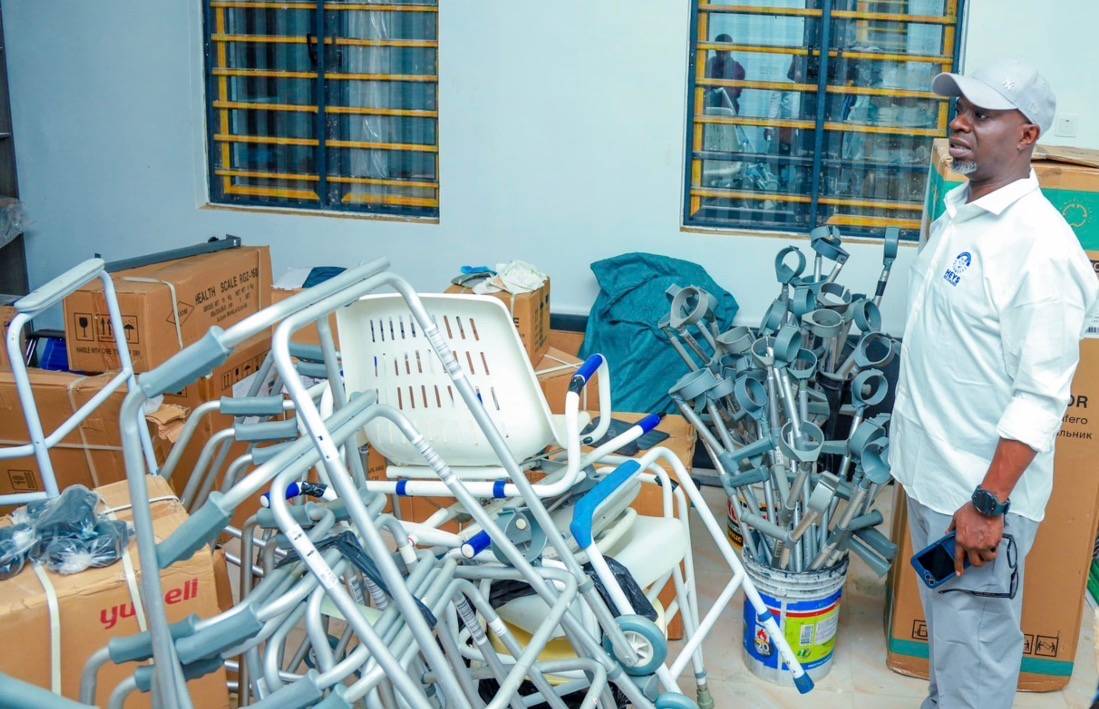Thyroid cancer rates are increasing in some parts of the world – and faster than other forms of cancer. Why?
Rates of thyroid cancer are increasing at a faster speed in the US than any other cancer. But what is behind this mysterious epidemic?
The thyroid gland sits at the base of the neck, just below the Adam’s apple. Its job is to release hormones that regulate heart rate, blood pressure, body temperature and weight. Thyroid cancer occurs when the cells within the thyroid gland start to grow and divide uncontrollably, forming a tumour. These abnormal cells can invade surrounding tissues and potentially spread to other parts of the body.
Although most cases of thyroid cancer are curable, health experts are concerned by how quickly rates of the disease are increasing.
According to the Surveillance, Epidemiology, and End Results (Seer) database – a cancer reporting system in the United States – the incidence of thyroid cancer in the US more than tripled between 1980 and 2016, rising from 2.39 to 7.54 per 100,000 in men, and 6.15 to 21.28 per 100,000 in women.
“Thyroid cancer remains one of the few cancers that has been on the rise over time, despite advances in medicine,” says Sanziana Roman, an endocrine surgeon at University of California San Francisco (UCSF).
So, what is behind this uptick in cases?
It’s long been known that exposure to large amounts of ionising radiation in childhood can cause thyroid cancer. In the years following the Chernobyl nuclear accident in 1986, rates of the disease skyrocketed in children in Belarus, Ukraine and Russia. One study found that amongst Japanese atomic-bomb survivors, about 36% of thyroid cancer cases since 1958 could be attributed to childhood radiation exposure.
However, there were no nuclear disasters in the US in the ’80s or ’90s, or elsewhere, that could explain such a rise. At first experts were baffled, however eventually an explanation presented itself – could better diagnosis be to “blame”?
In the 1980s, doctors began to use thyroid ultrasonography for the first time, an imaging technique that uses sound waves to create pictures of the thyroid gland. This allowed physicians to pick up very small thyroid cancers that would previously have been undetectable.
Then in the 1990s, medics also started collecting cells from suspicious lumps to determine if they were cancerous, a technique known as a fine needle aspiration biopsy.
Overdiagnosis of these cancers led many people to have unnecessary medical interventions
“In the past, physicians would feel the thyroid gland to look for nodules”, says Cari Kitahara, an epidemiologist at the National Cancer Institute in Maryland, the US.
“But with techniques like ultrasonography, doctors could pick up smaller-sized nodules and then biopsy them. This led to increased detection of small-sized papillary thyroid cancers that in the past wouldn’t have been felt through palpation [using the hands to physically examine a patient’s body].”
Other evidence also supported the over-diagnosis theory. For example, while rates of thyroid cancers were accelerating, deaths from thyroid cancer appeared to remain stable. Meanwhile incidences of thyroid cancer skyrocketed in South Korea when a national thyroid cancer screening programme was introduced. They fell again when the programme was scaled back.
“Together these patterns were consistent with over-diagnosis, or the increased detection of disease that would probably never cause symptoms or death to those individuals if they had been left undetected,” says Kitahara.
We now know that small papillary thyroid cancers are usually slow-growing and often respond well to treatment. They are rarely fatal and have a good prognosis. But at the time, overdiagnosis of these cancers led many people to have unnecessary medical interventions, including total removal of the thyroid gland, followed by radioactive iodine treatment to remove any remaining cells. Surgery can sometimes lead to vocal cord paralysis, while treatment with radioactive iodine can also raise the risk of secondary cancers.
Changes to clinical practice have since been made in the US so that radioactive iodine is now only used to treat aggressive cancers, while doses are minimised to reduce the risk of side effects. Rather than total removal of the thyroid gland, doctors often partially remove it, or take a watchful waiting approach.
As a result, the latest statistics from Seer suggest that thyroid cancer cases have now stabilised in the US. For example, in 2010 there were on average 13.9 new cases per 100,000, while in 2022 – the last year for which statistics are available – there were 14.1 cases per 100,000.
Nevertheless, over the last few years, some scientists have argued that overdiagnosis by itself cannot explain all of the increase seen.
In one study, Riccardo Vigneri, emeritus professor of endocrinology at the University of Catania, Italy, argues that if that were the sole explanation behind the rise in cases then you might expect thyroid cancer cases to increase more in high-income countries with better diagnostic practices. That is not the case, however, as middle-income countries have also seen thyroid cancer numbers grow.
“Thyroid cancer rates are increasing even in settings and regions of the world without robust screening,” says Roman.
“Larger and more advanced tumours are also being diagnosed more frequently. This suggests we are seeing a combination of both detection bias and true increases in disease incidence.”
What’s more, as thyroid cancers have increasingly been diagnosed at earlier stages, and treatment outcomes have improved, Vigneri says you would expect the number of people dying from thyroid cancer to fall. However, the death rate has remained stable at around 0.5 cases per 100,000 inhabitants, and there are signs that, at least in some countries, rates are increasing.
For instance, one study analysed more than 69,000 thyroid cancer patients diagnosed between 2000 to 2017 in California. The researchers found that both the number of people diagnosed, and the mortality rate increased over the time period. The increase was irrespective of tumour size and stage of the cancer, suggesting that there must be something else at play rather than simply improved diagnosis of extremely small tumours.
In 2017, Kitahara and her team also examined the medical records of over 77,000 thyroid cancer patients diagnosed between 1974-2013. The results showed that, while most of the increase in cases was driven by small papillary tumours localised to the thyroid gland, there was also an increase in metastatic papillary cancers that had spread to other parts of the body. While deaths from thyroid cancer are rare, the study also showed these were increasing at a rate of 1.1% per year.
“This suggested that there could be something else that could be driving the increase in these more aggressive tumours,” says Kitahara.
One of the main suspects is obesity, which has been rising in prevalence since the 1980s, particularly in the US and other developed countries. Cohort studies, which start with a healthy population and then follow them over time, appear to show a link between excess weight and thyroid cancer risk. People with a high BMI are more than 50% more likely to go on to be diagnosed with thyroid cancer during their lifetime compared to individuals with a healthy BMI.
A high BMI is also linked to aggressive tumour features, such as being larger in size at diagnosis, or having a mutation that causes the cancer to spread more easily.
“In our research we also saw that higher BMI was linked to higher risk of thyroid cancer related death,” Kitahara says. “So that was pretty strong evidence that this wasn’t just detection bias. It wasn’t just because people who had higher BMI were more likely to go to the doctor and have their thyroid checked, and that’s why they had more thyroid cancer. It was evidence that having a higher BMI was more likely to be related to thyroid cancer development and progression.”
Just how obesity could be causing thyroid cancer is less clear, however. One thing that is known is that people with obesity are more likely to have thyroid dysfunction. For instance individuals with high levels of Thyroid Stimulating Hormone (TSH), a hormone produced by the pituitary gland that regulates the thyroid gland’s function, also tend to have higher BMI.
“We still don’t fully understand the potential underlying mechanisms, as this is still an understudied area of research, but it could be multifactorial,” says Kitahara.
“Obesity has a lot of physiological effects, so inflammation, insulin resistance, and changes in thyroid function could all play a role in driving the development of thyroid cancer.”
Other scientists suspect that “endocrine disrupting chemicals” (EDCs) found in common household products and organic pesticides could be responsible. These are chemicals that mimic, block, or interfere with the body’s hormones. Examples include perfluorooactanoic acid (PFOA) and perfluorooctanesulfonic acid (PFOS), found in items ranging from cookware and paper food packaging to personal care products, carpeting and firefighting foam. However the evidence linking such chemicals to thyroid cancer is mixed.
Other studies suggest that trace elements may play a role. Trace elements are chemical elements that are only needed in very small amounts by living organisms. However, they are vital for thyroid function.
“We see really high rates of thyroid cancer in island countries,” says Kitahara.
“There have been hypotheses about trace elements related to volcanic eruptions. So zinc, cadmium, some other chemicals such as vanadium have been shown to be present in these environments, along with high rates of thyroid cancer, but there haven’t been a lot of well-designed epidemiologic studies to support a direct link.”
However, Kitahara believes that there may be another explanation – ionising radiation from diagnostic medical scans. The number of CT and X-ray scans used, especially in the United States, has increased significantly since the ’80s, and that includes CT scans given to children. These CT scans yield relatively high doses of radiation to the thyroid gland.
Knowing what we know about the relationship between radiation and thyroid cancer from other studies, such as those on Japanese atomic bomb survivors, we can model the effects of such radiation. For example one recent study estimated that about 3,500 thyroid cancers a year, moving forward, are going to be directly attributable to CT scan rates in the United States.
“The young thyroid gland is more vulnerable to the effects of radiation exposure than thyroid gland in older people,” says Kitahara. “So it’s possible that the rising use of CT scans could contribute in part to the rising rates of thyroid cancer in the United States and elsewhere.”
And it is also possible that all of these factors may have a combined role.
“We’re likely observing a multifactorial phenomenon that includes environmental, metabolic, dietary and hormonal influences, possibly interacting with underlying genetic susceptibility,” says Roman.
BBC













